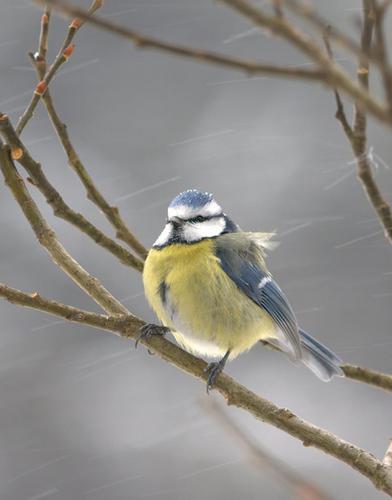当前位置:
X-MOL 学术
›
J. Anim. Ecol.
›
论文详情
Our official English website, www.x-mol.net, welcomes your feedback! (Note: you will need to create a separate account there.)
Timing of arrival in the breeding area is repeatable and affects reproductive success in a non‐migratory population of blue tits
Journal of Animal Ecology ( IF 4.8 ) Pub Date : 2020-04-01 , DOI: 10.1111/1365-2656.13160 Carol Gilsenan 1 , Mihai Valcu 1 , Bart Kempenaers 1
Journal of Animal Ecology ( IF 4.8 ) Pub Date : 2020-04-01 , DOI: 10.1111/1365-2656.13160 Carol Gilsenan 1 , Mihai Valcu 1 , Bart Kempenaers 1
Affiliation

|
Events in one part of the annual cycle often affect the performance (and subsequently fitness) of individuals later in the season (carry-over effects). An important aspect of this relates to the timing of activities. For example, many studies on migratory birds have shown that relatively late-spring arrival in the breeding area reduces both the likelihood of getting a mate or territory and reproductive success. In contrast, relatively little is known about the movements of individuals in non-migratory populations during the non-breeding season. Few studies have investigated the timing of arrival at the breeding area in such species, possibly due to the assumption that most individuals remain in the area during the non-breeding season. In this study, we used 4 years of data from a transponder-based automated recording system set up in a non-migratory population of blue tits Cyanistes caeruleus to describe individual variation in arrival at the breeding site. We investigated whether this variation can be explained by individual characteristics (sex, body size or status), and we assessed its effect on aspects of reproductive success in the subsequent breeding season. We found substantial variation in arrival date and demonstrate that this trait is individual-specific (repeatable). Females arrived later than males, but the arrival dates of social pair members were more similar than expected by chance, which suggests that individuals may mate assortatively depending on their arrival in the breeding area. Arrival predicted both whether an individual would end up breeding that season and several aspects of its breeding success. Our study suggests that individuals of non-migratory species leave the breeding area during the non-breeding season. Hence, it may be useful to consider variation in the scale of movements between breeding and non-breeding sites, rather than using a simple dichotomy between 'resident' and 'migratory' species. We conclude that the timing of pre-breeding events, in particular arrival date, may be an overlooked, but important, fitness-relevant trait in non-migratory species.
中文翻译:

到达繁殖区的时间是可重复的,并影响非迁徙蓝山雀种群的繁殖成功
年度周期某一部分中的事件通常会影响本赛季后期个体的表现(以及随后的健康状况)(结转效应)。这其中的一个重要方面与活动的时间安排有关。例如,许多关于候鸟的研究表明,相对较晚的春天到达繁殖地区会降低获得配偶或领地的可能性以及繁殖成功的可能性。相比之下,人们对非繁殖季节非迁徙种群中个体的迁移知之甚少。很少有研究调查这些物种到达繁殖区的时间,这可能是因为假设大多数个体在非繁殖季节留在该地区。在这项研究中,我们使用了基于转发器的自动记录系统的 4 年数据,该系统在蓝山雀 Cyanistes caeruleus 的非迁移种群中建立,以描述到达繁殖地点时的个体差异。我们调查了这种变异是否可以用个体特征(性别、体型或状态)来解释,并且我们评估了它对随后繁殖季节繁殖成功方面的影响。我们发现到达日期有很大差异,并证明这种特征是个体特定的(可重复的)。雌性比雄性晚到达,但社会对成员的到达日期比偶然预期的更相似,这表明个体可能会根据他们到达繁殖区的情况进行分类交配。到达预测了一个人是否会在那个季节最终繁殖,以及繁殖成功的几个方面。我们的研究表明,非迁徙物种的个体在非繁殖季节离开繁殖区。因此,考虑繁殖地和非繁殖地之间移动规模的变化可能是有用的,而不是在“常住”和“迁徙”物种之间使用简单的二分法。我们得出的结论是,在非迁徙物种中,繁殖前事件的时间,特别是到达日期,可能是一个被忽视但很重要的与健康相关的特征。考虑繁殖地和非繁殖地之间移动规模的变化可能是有用的,而不是在“常住”和“迁徙”物种之间使用简单的二分法。我们得出的结论是,在非迁徙物种中,繁殖前事件的时间,特别是到达日期,可能是一个被忽视但很重要的与健康相关的特征。考虑繁殖地和非繁殖地之间移动规模的变化可能是有用的,而不是在“常住”和“迁徙”物种之间使用简单的二分法。我们得出的结论是,在非迁徙物种中,繁殖前事件的时间,特别是到达日期,可能是一个被忽视但很重要的与健康相关的特征。
更新日期:2020-04-01
中文翻译:

到达繁殖区的时间是可重复的,并影响非迁徙蓝山雀种群的繁殖成功
年度周期某一部分中的事件通常会影响本赛季后期个体的表现(以及随后的健康状况)(结转效应)。这其中的一个重要方面与活动的时间安排有关。例如,许多关于候鸟的研究表明,相对较晚的春天到达繁殖地区会降低获得配偶或领地的可能性以及繁殖成功的可能性。相比之下,人们对非繁殖季节非迁徙种群中个体的迁移知之甚少。很少有研究调查这些物种到达繁殖区的时间,这可能是因为假设大多数个体在非繁殖季节留在该地区。在这项研究中,我们使用了基于转发器的自动记录系统的 4 年数据,该系统在蓝山雀 Cyanistes caeruleus 的非迁移种群中建立,以描述到达繁殖地点时的个体差异。我们调查了这种变异是否可以用个体特征(性别、体型或状态)来解释,并且我们评估了它对随后繁殖季节繁殖成功方面的影响。我们发现到达日期有很大差异,并证明这种特征是个体特定的(可重复的)。雌性比雄性晚到达,但社会对成员的到达日期比偶然预期的更相似,这表明个体可能会根据他们到达繁殖区的情况进行分类交配。到达预测了一个人是否会在那个季节最终繁殖,以及繁殖成功的几个方面。我们的研究表明,非迁徙物种的个体在非繁殖季节离开繁殖区。因此,考虑繁殖地和非繁殖地之间移动规模的变化可能是有用的,而不是在“常住”和“迁徙”物种之间使用简单的二分法。我们得出的结论是,在非迁徙物种中,繁殖前事件的时间,特别是到达日期,可能是一个被忽视但很重要的与健康相关的特征。考虑繁殖地和非繁殖地之间移动规模的变化可能是有用的,而不是在“常住”和“迁徙”物种之间使用简单的二分法。我们得出的结论是,在非迁徙物种中,繁殖前事件的时间,特别是到达日期,可能是一个被忽视但很重要的与健康相关的特征。考虑繁殖地和非繁殖地之间移动规模的变化可能是有用的,而不是在“常住”和“迁徙”物种之间使用简单的二分法。我们得出的结论是,在非迁徙物种中,繁殖前事件的时间,特别是到达日期,可能是一个被忽视但很重要的与健康相关的特征。



























 京公网安备 11010802027423号
京公网安备 11010802027423号